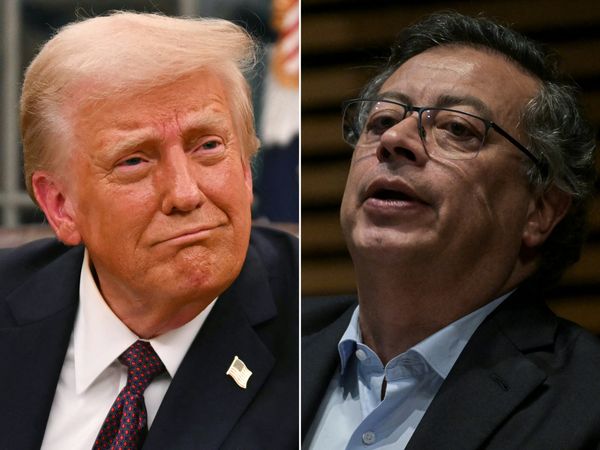
Just when you think you’ve got the measure of Leonardo da Vinci – painter, anatomist, pioneer of flight, animal-rights prophet – he turns out to have one more talent up his sleeve. On the 500th anniversary of his death on 2 May, art historian Martin Kemp has collaborated with early music singers I Fagiolini to create a tour and album centred on an aspect of Leonardo’s polymathy we can’t directly know – his musicianship.
Leonardo himself hinted why his talent as a musician would end up being the least-known of his abilities, point out Kemp and I Fagiolini’s director Robert Hollingworth, during a rehearsal at the Barbican. The trouble with music, he said in his notebooks, is that it is ephemeral – a fleeting beauty. Not even Leonardo dreamed recorded music could exist. He played a kind of fat violin called the lira da braccio, for which there were not even written scores. Playing it “was the Renaissance version of playing the blues”, says Hollingworth. You improvised on its deep acoustics while singing melancholy verses.
So Leonardo’s musical genius is an elusive legend. When he was about 31 and a struggling artist in Florence, wrote his first biographer Giorgio Vasari in 1550, he was invited to the court of Milan – not to paint, but play his customised lira da braccio: “and Leonardo took with him that instrument which he had made with his own hands, in great part of silver, in the form of a horse’s skull – a thing bizarre and new – in order that the harmony might be of greater volume and more sonorous in tone …”

This sounds like one of Vasari’s fishier fables, but Kemp thinks the core of it is true. He shows me another piece of evidence suggesting that Leonardo was famous in his time as the Jimi Hendrix of the lyre. It’s a 1505 print by the engraver Marcantonio Raimondi – later to be imprisoned for his part in producing the Renaissance pornographic bestseller The Positions. It has traditionally been seen as a depiction of the mythic poet Orpheus playing to the beasts, but in 2015 music expert Ross Duffin recognised that it looks exactly like Leonardo. Orpheus has the same clean profile and long hair as a drawing in the Royal Collection that Kemp insists is “the only authentic portrait” of Leonardo.
As I Fagiolini rehearse, I feel as if I am entering the musical world in which Leonardo wowed his listeners, half a millennium ago. They stand in line, their contrasting voices mixing in delicious harmonies. In Renaissance paintings such as Titian’s The Concert, there’s a tremulous, haunting sense of social, even sexual, dynamics between singers. As I watch these vocalists recreating Renaissance polyphony, I understand those paintings. When all music was live, it meant that all music was social. And that, according to Vasari, is how Leonardo used it. When he was portraying Mona Lisa, the wife of Florentine silk merchant Francesco del Giocondo, says Vasari, he got musicians to play and sing for her, to keep that smile on her face.
Leonardo’s musical skill helps to explain how an illegitimate kid from the Tuscan countryside became a star at the courts of Europe. After his performance on the lira da braccio helped secure him a job at the court of Milan, he stayed there for nearly two decades, and later became court artist to the King of France. Not only could he bring refined parties to life with his playing and singing but he worked on many court masques and festivals, pioneering the audio-visual courtly spectacles that would evolve a few decades after his death into the last great invention of Renaissance Italy – opera.
Perhaps this is why Kemp and Hollingworth couldn’t resist including Claudio Monteverdi, whose 1607 work L’Orfeo is the earliest opera still part of today’s opera house repertoire, in their programme. There are already enough recordings of early music from the era of Leonardo, explains Hollingworth. Yet one thing we know about Leonardo is that he wasn’t like anyone else. His art has an extra dimension that makes his contemporaries look flat, and a universality that transcends time. So while their performances and recording includes one contemporary whom he probably met, the French composer Josquin des Prez, it ranges right across what Kemp calls the “long Renaissance”– from the 15th to 18th centuries – to encompass the mysticism of Thomas Tallis and the mathematical elaborations of Johann Sebastian Bach. There’s even a specially commissioned piece with music by Adrian Williams and words by Gillian Clarke, which pays homage to Leonardo’s passion for flight.
The result is an eclectic search for the lost sound of Leonardo that would surely have appealed to his inventive mind. As the voices of I Fagiolini create waves and ripples of ethereal sound, I visualise the Mona Lisa shimmering in soft colours that merge in a kind of visual polyphony. And as the hall fills with early music’s good vibrations, I get why Leonardo employed musicians to make her smile. I find that I’m smiling too.
• At St George’s, Bristol on 2 May and touring. The album, Leonardo: Shaping the Invisible is out now on Coro







